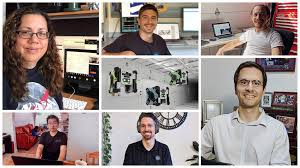
From his In-laws’ home in Palmares, Alajuela, a Costa Rican scientist was part of the NASA team that remotely worked with astronaut Chris Cassidy – who is on the International Space Station (ISS) – in a series of tests with one of the robots from the “Astrobee” program.
Josefino Andrés Mora and his companions carried out tests with the free-flying robot called “Honey” to verify that it will be at the full service of the ISS astronauts in a not so far away time, along with the other robot called “Bumble”.
This graduate in Electrical Engineering from the University of Costa Rica and an expert in engineering in space robotics says, “soon will be ready to carry out tasks and conduct scientific research on board the International Space Station.” This was confirmed by NASA in its newsletter this week, highlighting the fact that the six scientists worked from their homes, in light of the health protocols applied by the Institution due to the COVID-19 Pandemic.
The six scientists usually work from an operations unit located at the Ames Space Research Center, which NASA has in Silicon Valley, California. From that site they communicate with the ISS crew, send commands to the robots and receive measurements in real time.
“Due to the Pandemic, the team needed to adapt to the new teleworking conditions full time to meet the critical need of the NASA mission, with the goal of advancing autonomous robotics technology to play a leading role in the mission of the Agency to return to the Moon under the Artemis program,”added the report about the work of the six scientists, including the young Tico.
Mora has extensive experience in implementing mobile robot solutions that are used to solve real-world problems. At the Space Center, he has been involved in the research and development of autonomous mobile systems and in the development of proposals for innovative aerospace systems. For example, he led a project to develop a “Robotic Momentum Device Actuated Canfield” (MoDAC), that is a manipulator mechanical arm used in free-flying robots called SPHERES, which are aboard the International Space Station.
In addition to his involvement in Astrobee robots, Mora has also worked on developing an unmanned vehicle to study underground environments that are inaccessible to GPS technology.
And as a postdoctoral researcher at the School of Earth and Space Exploration (SESE) at Arizona State University (ASU) he worked on the design and implementation of robots and instrumentation for extreme environments such as hot springs, volcanoes, and subglacial lakes.
Strobe and its robots

Mora joined the Astrobee team five years ago. It is a generation of two robots in the form of compact cubes of 30 x 30 x 30 centimeters, which are designed for numerous tasks on the International Space Station. These are Bumble and Honey.
This new generation of robots was built on the success of SPHERES, NASA’s first generation of free-flying robots aboard the ISS. But, unlike these, the newer ones can take on research and maintenance tasks without needing to be supervised by astronauts. The strobe can operate in fully automatic mode or under remote control from Earth, so astronauts can spend their time on other tasks.
The strobe can navigate the space station to continually check items’ locations with their scanner, rather than requiring astronauts to spend their time doing this manually. Furthermore, the strobe can also monitor environmental conditions within the orbital complex, such as air quality or sound levels (which can be very strong at the station).
For NASA flight controllers, Astrobee will allow them to ‘fly’ around the Space Station without leaving one of the centers located in Houston. They can see and hear station activities through the microphone, and cameras of the free travelers, monitor and conduct experiments, or supervise routine tasks remotely, almost like being there.
They can also help develop new scientific research and test technology in so-called zero gravity, which is what is experienced when a body is not subjected to the force of gravity exerted by the Earth’s gravitational center.

